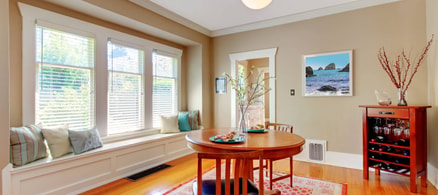In the same vein, homeowners in an increasing number of cities can now build a second home on their lots, thanks to zoning bylaw changes in several Canadian municipalities. Referred to as laneway homes, coach houses, or garden suites, these secondary homes are popping up in cities such as Vancouver, Calgary, Edmonton, Toronto and Ottawa.
But what exactly are these secondary homes, and does it make financial sense to build one? Here’s what to consider when determining if a laneway home, coach house or garden suite is a good investment for you.
What are laneway homes, coach houses and garden suites?
Laneway homes, coach houses and garden suites are all detached buildings that are on the same lot as your primary house. If your lot is adjacent to a public laneway and the secondary home faces or backs onto the lane, it’s called a laneway house. If there’s no lane, the secondary home is called a coach house or garden suite.
Either way, the secondary home’s utilities and services—including water, gas and electricity—are usually connected to the main home rather than to the street.
Depending on a municipality’s zoning bylaws and the size of the lot, these secondary homes can range from tiny suites on top of a garage to more than 1,000-sq.-ft. two-storey dwellings with a basement. They can be occupied by the owners as additional living space, used as a nanny or granny suite, or set up as rental properties.
Who can build a laneway home or garden suite?
Not all municipalities currently allow the construction of secondary homes. And those that do have different rules about which properties qualify and how to get approval to build.
In Vancouver, for example, where laneway homes have been permitted for more than a decade, homeowners must apply to the planning department for approval on a case-by-case basis. In Toronto, however, by-law amendments passed in 2018 allow “as-of-right” laneway housing. That means if your lot borders an eligible laneway and meets all the specified regulations (including minimum proximity to a fire hydrant), you can build a laneway home without special zoning approval. (Owners still need a building permit from the city, of course, but that’s no different from any construction project.)
Some cities in Canada, such as Edmonton, have similar “as-of-right” rules to build coach houses or garden suites. While Toronto has not yet approved garden suites, the city council is currently looking at the possibility and a vote on the issue could happen as early as this summer.
The bottom line: check with your municipality to see if laneway or garden suites are permitted and, if so, what the rules are.
How much does it cost to build a laneway house?
While it depends on your location and the size and type of build, the ballpark cost is about $300,000 to $500,000.
For example, a Toronto homeowner recently spent $330,000 to build a two-storey laneway home with a one-bedroom suite over a garage, while a Vancouver homeowner spent $510,000 to build a 1,040-sq.-ft. two-storey laneway home (plus an enclosed garage).
These costs include architectural designs, permits, construction materials and labour, as well as land development charges, where applicable. (Toronto has a deferral program on development charges for laneway homes, which can save homeowners $40,000 or more.)
Other expenses you should factor in are borrowing costs (i.e., interest payments on a HELOC or mortgage), and higher home insurance premiums, property taxes, and utility bills.
What are the financial benefits of building a laneway house?
There are several ways you can profit from a laneway home:
Increase your property value
Any time you add square footage of livable space to a property—whether that means finishing a basement, building a third-floor addition, or constructing a laneway home—you increase your property value. Depending on the housing market in your area, the increase in property value can be significantly greater than what you spent on construction, which will pay off when/if you decide to sell.
Earn rental income
The Toronto homeowner mentioned above, for example, is renting out his one-bedroom laneway suite for $1,800 a month. Even if he borrowed the full $330,000 that it cost to build, his mortgage would be around $1,450 per month (with a current 5-year fixed-rate mortgage of 1.79%). That means his tenant is, in effect, paying the carrying costs plus an extra $350 per month.
Now consider that the owner plans to move into the laneway suite himself in a few years (once his kids are grown) and rent out his main house. At current market rates, his three-bedroom, two-bathroom semi would command monthly rent of at least $2,500—meaning he’ll pocket more than $950 a month in rental income over and above his monthly mortgage payment. Plus, he can take advantage of tax deductions on rental properties.
If the homeowner had bought a one-bedroom condo in Toronto instead as an income property, he would have paid nearly twice as much (about $575,000, at current market rates). The higher mortgage payments—not to mention the monthly condo fees—would far exceed the rent he could get on the place.
Clearly, the laneway home is a much better investment.
Provide detached housing for a loved one at a fraction of the cost of buying
That’s what the Vancouver owner above did. Her daughter and son-in-law couldn’t afford to buy a home in Vancouver for themselves and their three kids, as even the smallest detached homes there now sell for close to $2 million. So, Mom came to the rescue, building a nicely sized 1,040-sq.-ft. laneway home at about a quarter of the cost, which the couple now owns jointly with her.
Pros and cons of building a laneway house
Pros
Aside from the financial costs and benefits outlined above, there are some lifestyle factors to consider before deciding to build a laneway house. Here are the main pros and cons.
- Flexibility: You can choose to rent out a laneway home, use it as a guest house or home office space, provide accommodations for a child or parent—or do all of the above at different periods in your life.
- You can keep family close: In cities where even rental accommodations are prohibitively high, a laneway home can be an affordable option for an adult child or downsizing parents who might otherwise have to leave the city. Some owners who build a laneway home for an adult child expect to do a “swap” at some point, so the child and his/her family will move into the main house and the parents will move into the laneway suite where they can be involved grandparents and help out with childcare.
- Convenience: As a landlord, a laneway suite rental is less of an intrusion to you than a basement apartment, where sounds are more likely to carry. At the same time, you can keep a close eye on your income property and easily handle any necessary repairs.
Cons
- Privacy: Unless you plan to use the laneway home as extra space for yourself and your family, you have to be okay with a tenant living literally in your backyard. For some, that may feel too close for comfort.
- Construction chaos: Building another home on your property is not for the faint of heart. It’s loud, dirty and there are always at least a few unexpected problems that can derail your plans and cause delays.
- Smaller yard: In most cases, you’ll have to give up some of your backyard to build a laneway home. Garden suites, obviously, will also leave you with less outdoor space.
Current demand for laneway houses
In 2020, about 100 laneway houses were either built or ready to be built in Toronto, and another 300 were approved in Vancouver. But demand to build secondary homes could take off in the next year or two as homeowners see them pop up in their communities and become aware of the benefits.
Plus, if Toronto approves garden suites later this year, the number of owners who could potentially build secondary homes will expand from the current 30,000 who have lots on suitable laneways, to hundreds of thousands of homeowners across the city.
From a renter’s perspective, laneway and garden suites offer an attractive alternative to high-rise and other multi-unit apartment buildings or condos. Instead of putting up with neighbours’ sounds, and smells (and, in COVID times, aerosol emissions), laneway suites provide a single-family detached home experience. There’s nobody above you or on the other side of the wall, no common spaces to navigate or elevators to share—you just walk outside from your front door.
Because of these advantages, owners can often charge a premium for rentals in a laneway home or coach house, as compared to a similarly sized basement apartment or condo rental.
FAQs
Can laneway houses be sold?
Depending on where you live, it’s either impossible or extremely challenging to sell a laneway home unless you’re selling the entire property—including the main house. That’s because you’d have to sever the lot, and most municipalities won’t allow it. After all, the whole point of encouraging the construction of laneway homes and garden suites is to create more rental housing in cities where rents are becoming unaffordable, not to build more homes for sale. Of course, if market conditions change, it’s possible the rules will be amended in the future to allow lots to be severed.
How does laneway housing contribute to your property value?
The value of your property is essentially the price another buyer is willing to pay for it. Buyers will, obviously, pay a premium for a property that has a second home that can be rented out, house relatives or provide additional space to live and work. How much more a buyer is willing to pay depends entirely on the housing market where you live. But, in most cases, the increase in property value is likely to be more than you spent on the build.
Can I rent my laneway home through AirBnB?
While it depends on the region’s bylaws, most cities, including Toronto, do not allow short-term rentals in laneway homes.

-1691522833-1696430299.jpg)



